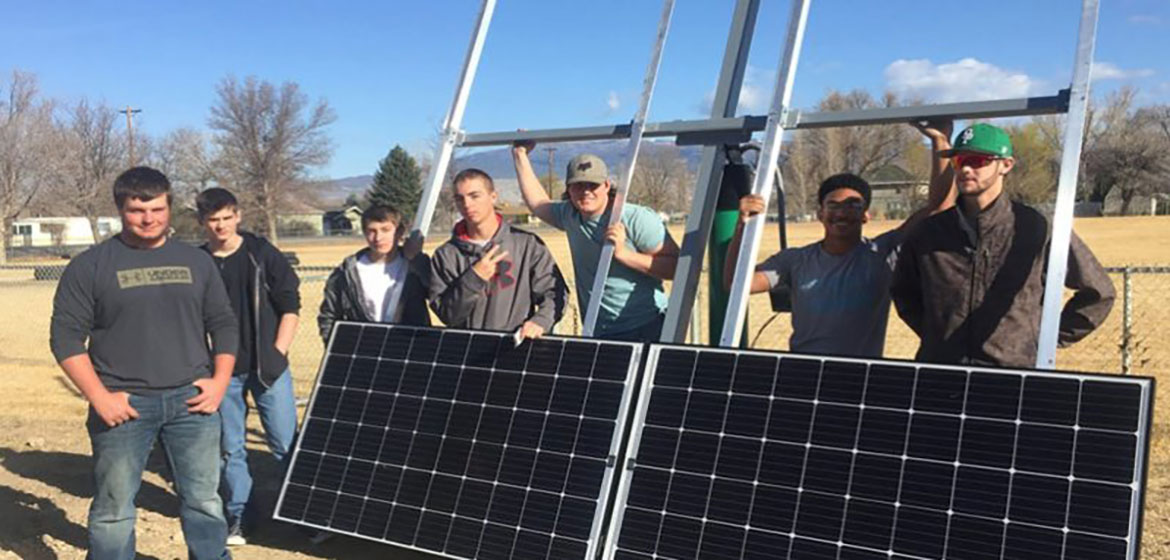By Sarah Biren
A cluster of elementary school kids sit at a picnic table in a grassy field, avidly watching 18-year-old Xavier Baty connect a solar panel cell to a small motor hooked up to a fan. With precise movements, he holds the panel toward the setting sun and shifts it slightly to change the speed of the fan.
“Want to hear a secret?” he says to his audience. “This is the only science class I ever got an A in.”
Solar Energy Training for Students
By “this science class,” Baty refers to a group of fellow high school seniors and juniors who had enrolled in a Solar Energy Training program, which provides the science credit they need to graduate and trains them for jobs in solar energy or the electrical field. It gives students like Baty the opportunity to work with their hands while preparing them for employment in a growing industry.
In Colorado’s North Fork Valley, the coal industry that has supported the residents for 120 years is now dying, leaving an economic void they are filling with solar energy.
When the mines were functioning at full capacity, high school seniors had well-paying jobs waiting for them upon graduation. However, two out of Delta’s County’s three mines have closed in the last five years, closing 900 local jobs with them. The community developed a smart way to sustain the area while providing careers for their young adults. As mining companies go out of business, renewable energy become cheaper, creating hope for coal-free future. Delta County had to re-adjust — and quickly.
“Unlike some places that have a more gradual off-ramp or predictable decline, these mine closures came suddenly and significantly, allowing for little advance planning or preparation for what would come next,” explained a report by the Resource Legacy Fund.
Ethan Bates is another high school senior in the solar energy training program, and the son of a former mine foreman who had to resign when the Bowie Mine closed three years ago. Bates will graduate as a certified solar panel installer. Fortunately for him and his fellow graduates, Delta has one of the highest potentials for solar photovoltaic in the state, according to the NOAA Plane Stewards Education Project, who helped fund the program.
Nontraditional Science Class
Ben Graves, a science teacher the students describe as “cool” with a “mad-scientist vibe,” began the training program four years ago. Educating young adults and setting them up to be successful citizens is his priority, and to do that, he needed to consider the current economy.
“I think we have to be doing some sort of trades education,” he said. “For a kid with a high school diploma, working service is really all you can do without more training.”
With his program, students with barely passable science grades who “haven’t played the school game of standardized tests,” according to Graves, are now trained in electrical trades. In the past four years, the students have installed two solar arrays behind the high school, doing all of the manual labor of digging the trenches for the conduit cables and designing the structures. This year, they are assigned to taking apart and re-installing one of these arrays.
“Reinvention starts with generating community awareness, changing attitudes, and providing opportunities to master new skills through hands-on technical training,” Graves said to NOAA.
Changes for Renewable Energy
This program has inspired teachers at other schools to bring solar training into their curriculum. The local nonprofit, Solar Energy International, is working to integrate this program into science studies across the region.
“The facilities folks at first waved it away as a class project,” Graves said. “Now, maintenance sees it as a real way to reduce demand charges. It went from us pushing some of this stuff on the administration to them saying, ‘Wait a second, we actually want this.’”
On a weekday, the projects can supply 10% of the high school’s energy demand; 30% on weekends. There’s a limit on much solar the class can install because of a municipal cap, but this still makes a difference monetarily and for the environment. In just 2018, Graves’s program stopped 1.38 tons of carbon dioxide from being released into the atmosphere.
The switch to solar energy is rippling to Delta at a county level. Delta-Montrose Electric Association, the area’s electric cooperative, is closing their contract with its wholesale power supplier that is notorious for relying on coal-fired power plants and limiting renewables. Solar gives its residents the opportunity to become self-sufficient, as solar powers on homes and businesses become more common. The DMEA is funding solar arrays to every high school in its district, as well as giving grants to Graves’s class, and training teachers in solar energy.
The Delta County is become true to its name, since the Greek letter delta is a scientific symbol for change.
“The student-built array is a visible reminder to the community and its leadership that solar electricity is a viable way to reduce the community’s energy demand,” said Graves, “while having a positive impact on climate change, saving money in the long run, and transforming the community into a renewable energy hub.”
Source:
Related to SDG 7: Clean and affordable energy



